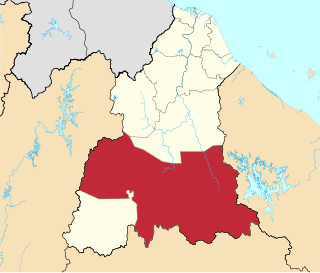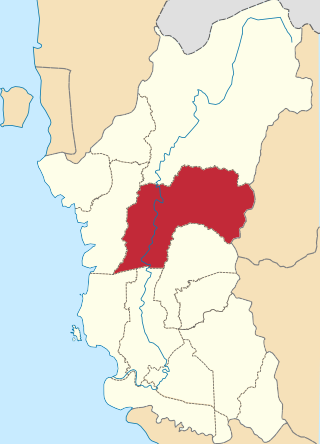
The Semang are an ethnic-minority group of the Malay Peninsula. They live in mountainous and isolated forest regions of Perak, Pahang, Kelantan and Kedah of Malaysia and the southern provinces of Thailand. The Semang are among the different ethnic groups of Southeast Asia who, based on their dark skin and other perceived physical similarities, are sometimes referred to by the superficial term Negrito.

The Cameron Highlands is a district in Pahang, Malaysia, occupying an area of 712.18 square kilometres (274.97 sq mi). To the north, its boundary touches that of Kelantan; to the west, it shares part of its border with Perak. Situated at the northwestern tip of Pahang, Cameron Highlands is approximately 90 kilometres (56 mi) east from Ipoh, roughly 200 kilometres (120 mi) north from Kuala Lumpur or about 355 kilometres (221 mi) from Kuantan, the capital of Pahang. It is the smallest municipality in the state.

The Semai are a semi-sedentary ethnic group living in the center of the Malay Peninsula in Southeast Asia, known especially for their nonviolence. This characterization was made by Robert Knox Dentan, an anthropologist who studied the Semai in the 1960s, though he offered a more nuanced view after subsequent fieldwork. They speak Semai, an Austroasiatic language closely related to Temiar, spoken by Temiars nearby. The Semai are bordered by the Temiars to the north and the Jah Hut to the South. The Semai belong to the Senoi group, and are one of the largest indigenous ethnic group in the Peninsula and the largest of the Senoi group. Most Semai subsist by cultivating grain crops, hunting, and fishing.
East–West Highway or also known as Gerik–Jeli Highway, Kulim–Baling Highway and Titi Karangan–Gerik Highway, Federal Route 4, Asian Highway Route 140 is the 215 kilometres (134 mi) federal highway constructed by the Malaysian Public Works Department (JKR) to shorten the journey from Kota Bharu, Kelantan to northwestern towns and cities of Malaysia such as Alor Star, Kedah and Penang. The highway connects Gerik, Perak in the west to Jeli, Kelantan in the east, before being extended further to Lunas, Kedah.

The Batek people are an indigenous Orang Asli people ; belonging to the Semang group, who live in the rainforest of peninsular Malaysia. As a result of encroachment, they now primarily inhabit the Taman Negara National Park. The Batek are nomadic hunters and gatherers, so the exact location of their settlements change within the general confines of the area that they inhabit.
The Congress of Union of Employees in the Public and Civil Services Malaysia, abbreviated CUEPACS, is a national trade union centre in Malaysia. It has a membership of 1,200,000.

Gua Musang is a town, district and parliamentary constituency in southern Kelantan, Malaysia. It is the largest district in Kelantan. Gua Musang is administered by the Gua Musang District Council. Gua Musang district is bordered by the state of Pahang to the south, Terengganu to the east, Perak to the west and the Kelantanese districts of Kuala Krai and Jeli to the north. It is a small railway town about 140 km south of state capital Kota Bharu. Gua Musang is represented by Mohd Azizi Abu Naim in the Dewan Rakyat. The town lies on the KTM East Coast Line, from Tumpat, near the border with Thailand, to Gemas, Negeri Sembilan.

Sungai Siput (U) (Jawi: سوڠاي سيڤوت; Tamil: சுங்கை சீப்புட்) (English: Snail River) is a town and mukim in Kuala Kangsar District, Perak, Malaysia, covering 155.141 hectares, 61.5% of the total area of Kuala Kangsar. Sungai Siput falls under the management of the Kuala Kangsar Municipal Council.

The Perak River is the second longest river in Peninsular Malaysia after Pahang River in Pahang, Malaysia.

Maharajalela Monorail station is a Malaysian elevated monorail train station that forms a part of the Kuala Lumpur Monorail line located in Kuala Lumpur and opened alongside the rest of the train service on 31 August 2003.

Medan Tuanku Monorail station is a Malaysian elevated monorail train station that serves as a part of the Kuala Lumpur Monorail, located in Kuala Lumpur and opened alongside the rest of the train service on August 31, 2003. This station was formerly called Wawasan Monorail station, since the adjacent development project was named as “Bandar Wawasan” in Kampung Baru area.

The Mah Meri are an ethnic group native to western part of Peninsular Malaysia. They are one of the 18 Orang Asli groups named by the Malaysian government. They are of the Senoi subgroup. Most of the members of the Mah Meri tribe live along the coast of South Selangor from Sungai Pelek up to Pulau Carey, although there is at least one Mah Meri Community on the other side of the Klang River.

The Temuan people are a Proto-Malay ethnic group indigenous to western parts of Peninsular Malaysia. They can be found in the states of Selangor, Pahang, Johor, Negeri Sembilan and Malacca. The Temuans are classified as part of Orang Asli group according to the Malaysian government. They are also one of the largest and the most widespread of the Orang Asli ethnic groups.

The Kinta Valley is a conurbation in central Perak, Malaysia, surrounding and including the state capital Ipoh. Historically the Kinta Valley was very rich in tin, and their mines have been among the most productive in the world. The valley is formed by the Kinta River, a tributary of the Perak River, which flows between the Titiwangsa Mountains and the Kledang Range.

Malaysian Sikhs are known to be the fourth largest Malaysian Indian ethnic group. It is estimated that there are around 100,000 Sikhs in Malaysia.
The Lanoh are a group classified as "Orang Asli" of the Semang branch by the government of Malaysia. They live in the Malay Peninsula and number around 390. They are also known as Sabub'n or Lano. However, the Lanoh community in Gerik and Lenggong, Perak would identify to themselves as Menik Semnam, a name that refers to the Lanoh people that lived at the Semnam River. Whereas the Malay community in Upper Perak would refer the Lanoh people as Sakai Jeram.

The Jahai or Jehai people are an indigenous people of the Semang people group found in Perak and Kelantan, Malaysia and parts of Thailand. They have dark skin, often curly-hair and Asiatic facial characteristics, and are stockily built. They are hunter-gatherers and they occasionally practice swidden agriculture.

The Kuala Kangsar District is a district in Perak, Malaysia. Kuala Kangsar shares its borders with Larut, Matang and Selama at the west, Hulu Perak at the north, Gua Musang of Kelantan at the east, Kinta at the south, Perak Tengah and Manjung at the southwest. The seat of this district is the town of Kuala Kangsar.
















